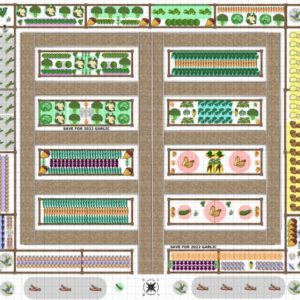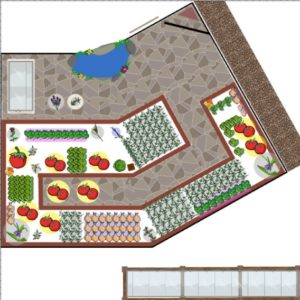The GARDEN SUMMER of 2021 was fabulous. Great weather, abundant harvests & no rodents made it a hit in my book. This year the pasture grasses stayed greener longer, the wildflowers flourished, and there were a good deal more ladybugs in the garden (and very few grubs).
Maybe next year I’ll get to the point of knowing just what to start when, and how much of each thing at a time. There were a few too many of some things and not enough of others. I’m getting much better at that each year, and if I follow through on this year’s notes next year, I should be good to go.
HIGHLIGHTS FIORETTO SPROUTING CAULIFLOWER: I’m really glad I found this sprouting cauliflower. I like this better than the regular crown type of cauliflower: it is much sweeter and delicious simply steamed. Some of them were beautiful & picture perfect like the one in the photo, others rather scraggly in appearance, but all of them were just as tasty no matter what they looked like.
FIORETTO SPROUTING CAULIFLOWER: I’m really glad I found this sprouting cauliflower. I like this better than the regular crown type of cauliflower: it is much sweeter and delicious simply steamed. Some of them were beautiful & picture perfect like the one in the photo, others rather scraggly in appearance, but all of them were just as tasty no matter what they looked like.
ONIONS: I started more onions much earlier than before, first in soil blocks under lights then transplanted to the greenhouse prior to going outside. All-in-all they did quite well in numbers, but still small-to-medium in size. I admit I planted them a little closer together than recommended, but perhaps in these conditions they just won’t get any larger. The more the merrier.
GREEN BEANS (BUSH): This year I grew the same bush beans, SPEEDY, and they over-performed. I might say that I have too many, but frozen beans are great and the freezer full of beans will provide many green bean casseroles along with just plain ole’ steamed green beans as a side. The lady bugs may have helped to keep the aphids off!

CELERY: This was my best celery year so far. I did a different variety this year, TANGO, so perhaps that contributed to the success. I also gave them a better start in the greenhouse prior to going outdoors. Too bad they don’t store very long and I don’t eat that much.
SQUASH: ZUCCHINI & the SMALL WONDER SPAGHETTI Squash were plentiful. See my newest favorite zucchini recipe HERE. The CELEBRATION harvest was fewer and BUTTERBUSH not so great. I won’t be doing Butterbush again.
BRASSICAS: In addition to the Fioretto, all the brassicas did well, as usual. No surprise there. We had lots of broccoli & broccolini, cauliflower, cabbage, brussels sprouts and rutabagas. I grew a bit too much cabbage & too many rutabagas, but next year I should get the amount more suited to my needs.
OTHER than the above, peas, lettuces, carrots, parsnips & beets all did well.
DISAPPOINTMENTS
GARLIC: I thought I may never bother with garlic again. The seed garlic I usually purchase through mail order is expensive, and the yield I get isn’t worth the cost. This year I planted 26 cloves and harvested just NINE wimpy little bulbs. Perhaps the winter was colder, or because I planted the garlic on one of the outer, perimeter shadier beds it got colder. I’m not sure. None of the garlic at the edge of the bed grew, only the inner row, and not all of those. I got some sale garlic this year, so I’m trying just one row in one of the inner beds, well protected in the center of the bed.

POTATOES: This year the potato plants certainly flourished, as seen in the photo, but unfortunately the yield wasn’t so great. This year I planted Chieftain (red) and Caribou (russet) potatoes. Both varieties were small in number and in size, but in good shape & delicious. Perhaps the trial planting method this year inhibited their growth. I tried placing the seed potatoes ON TOP of the soil, covering them with many layers of mulch, but apparently that didn’t work as well as promised.
ASPARAGUS: Most of the asparagus that came up this year was very skinny and froze before I had a chance to harvest it, even though it was covered with frost cloth. Not sure what to do about that.
ME: The only other “disappointment” is my inability to eat everything I grow before it goes bad, particularly the things that need to be eaten fresh. I need to do a better job of spacing things out.
GREENHOUSE
The only things grown in the greenhouse during summer months were TOMATOES & WINTER SQUASH which both did decently. I tried a new variety of tomatoes, Cordova, which suffered from some BLOSSOM END ROT & APHIDS, but eventually I managed to control them both to get some nice tomatoes off those plants. Some greenhouse space was planted with cover crops or let to rest. I really don’t need anything else in the greenhouse during the summer, and the rest period is good to prepare for a busy winter of growing.
COLD-CLOSET-ROOT-CELLAR
Aside from the garden itself, we’ve found that we can keep our “cold-closet” cold by adding ice to it in late summer after I begin harvesting root veggies and before the nights are cool enough to keep it cold. Now that our electricity is solar, we don’t pay any extra to use the freezer space for freezing ice. Several water bottles frozen and swapped with another batch of frozen bottles every other day or so kept the cold closet around 45 degrees beginning the end of August when we needed it for beets & rutabagas. (Next year I plan to start the ruties & beets later in the summer for a later harvest, thus enabling them to store longer into the winter.)
FALL & WINTER
GREENHOUSE: For fall & winter the greenhouse is filled with tomatoes, lettuce, spinach, zucchini, cabbage, broccoli & cauliflower. I’ll be saving space for my “onion nursery” to begin in February, like last year.
OUTDOORS: The last of the potatoes, carrots & parsnips were harvested before the ground froze, mid-November. Most of the beds have been put to rest by topping them with compost which was made throughout the summer & fall. The remaining beds will wait for compost early in the spring.
Other than that, winter will hopefully be spent updating all of the vegetable pages here with growing instructions and recipes.
And playing radio!




